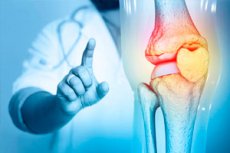New publications
Scientists warn of a "tsunami" of osteoarthritis cases by 2050
Last reviewed: 02.07.2025

All iLive content is medically reviewed or fact checked to ensure as much factual accuracy as possible.
We have strict sourcing guidelines and only link to reputable media sites, academic research institutions and, whenever possible, medically peer reviewed studies. Note that the numbers in parentheses ([1], [2], etc.) are clickable links to these studies.
If you feel that any of our content is inaccurate, out-of-date, or otherwise questionable, please select it and press Ctrl + Enter.

Osteoarthritis (OA) is a degenerative disease that affects weight-bearing joints. The knees, hips, spine, and small joints of the hands are most commonly affected. Two out of three people over 50 have creaking and creaking joints that cause daily pain and reduce mobility. The problem is growing as the population ages and more people become sedentary, overweight, and obese.
Osteoarthritis is also surprisingly common among young people, especially those with unhealthy lifestyles, poor diets, and athletic young people who have suffered traumatic joint injuries. In severe cases, arthritis can lead to significant disability.
Overall, osteoarthritis is a chronic condition that requires ongoing management to relieve symptoms and maintain joint function. Early diagnosis and appropriate treatment can help slow the progression of the disease and improve overall joint health.
Although osteoarthritis affects more than 500 million people worldwide, there is no treatment or approved medication to treat or prevent the disease, according to the World Health Organization. The only available treatments are painkillers, anti-inflammatory medications, and total joint replacement.
This highlights the societal impact of the disease and the need for greater action to develop more effective treatments that can be used to treat and prevent osteoarthritis.
New consortium to tackle the problem
By 2050, one in three people will suffer from osteoarthritis and there is currently no cure. That is why NetwOArk COST Action – the Open European Network on Osteoarthritis – aims to create a European Osteoarthritis Society. Launched in October 2022, the network brings together patients, clinicians and researchers from academia and industry in 17 countries.
NetwOArk aims to create an inclusive network and a new society that brings together all key stakeholders, including patients, patient advocacy groups, scientists, physicians, pharmaceutical companies, small and medium enterprises, medical device manufacturers and policymakers.
"COST Actions gives us, as a community of people interested in OA (patients, researchers, clinicians), the opportunity to create a real network! So with NetwOArk the next steps are and will be possible," says Corné Baatenburg de Jong, Chairman of NetwOArk.
This collaborative network highlights the urgent need to address this problem by raising awareness among the public and policy makers about the seriousness of osteoarthritis and its impact on society.
This is timely and important as the burden of osteoarthritis in Europe is enormous, with a 'tsunami' of osteoarthritis cases expected to hit health systems by 2050, potentially adding months and years to already unacceptably long waiting lists for joint replacement surgery.
Communication is the key to success
"Osteoarthritis is a serious disease that represents a significant global burden and remains a major barrier to free mobility in severe cases, resulting in significant morbidity in the ageing population. One of the main challenges is to communicate the latest research findings to patients, physicians and the general public.
"Another major challenge is to educate healthcare professionals on the latest treatment guidelines and research findings. The main goal of NetwOArk is to bring together all key players and create a strong community of European researchers dedicated to osteoarthritis research and clinical development," says Professor Ali Mobasheri, NetwOArk's scientific communication coordinator.
In the long term, NetwOArk aims to transfer this scientific knowledge to national OA patient organisations, clinicians and policy makers to create a strong European research platform. In addition, to transfer scientific knowledge from experimental research in the laboratory to the private sector to highlight the importance of prevention and facilitate the development of new treatments.
For the first time, the network consolidates and expands the efforts of national research programs in primary care, rheumatology, orthopaedics, public health, pain medicine, psychology, pharmacy, cell therapy, physical therapy, nutrition, public health, occupational therapy, epidemiology and health economics.
